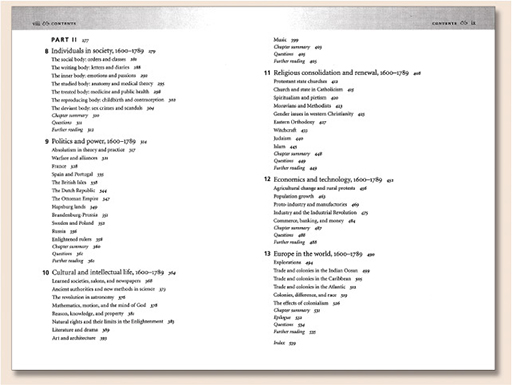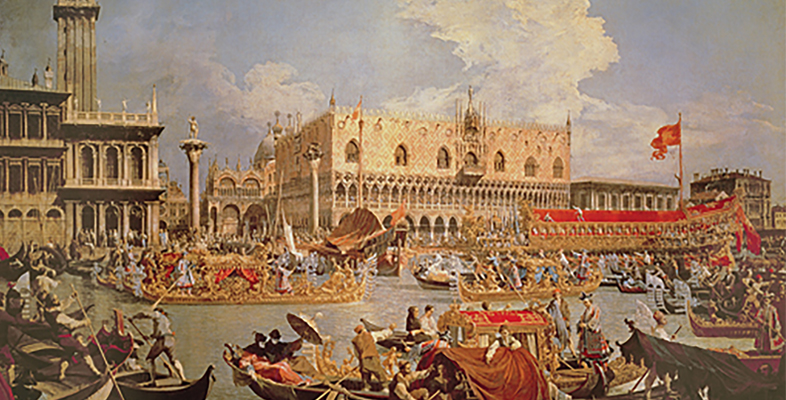4 What were the features of the early modern period?
As you read earlier, the beginning and end of the early modern period are marked by important changes in ideas, society, religion, economics and politics. But what about the period itself: what aspects of life and events characterise the time between 1500 and 1780?
Activity 2 What do you know about early modern Europe?
Take a few minutes to jot down anything you know about the period 1500–1780: any events that happened or people who lived between these dates. You may have encountered early modern history in many ways: as part of formal study, through books you have read for your own interest, through visits to buildings from that period, or through history programmes on the radio or television. Then try to put these events and people under the headings of ideas, society, religion, economics and politics. Don’t worry if nothing much comes to mind – just skip to the discussion.
Discussion
Everyone will have a different list of things. I’ve read a lot of books about early modern Europe while preparing materials for this course, but apart from that I’ve watched and read some material just out of interest. Over the last few months I’ve seen television programmes about the palace of Hampton Court and the lives of women in the eighteenth century. You may have seen something similar – Henry VIII (1491–1547, reigned 1509–1547) and Elizabeth I (1533–1603, reigned 1558–1603) are popular topics for television history. I’ve also heard a radio dramatisation of the diary of Samuel Pepys (1633–1703) that included an account of the Great Fire of London in 1666. A number of years ago I lived in Edinburgh, which has many buildings surviving from the early modern period, including the New Town, which was begun in the 1770s.
So, to summarise, I’ve come across materials that tell me something about early modern society through the lives of elite and ordinary people, something about politics through accounts of royal power, as well as a depiction of a major event; and I have some knowledge of an early modern city.
What do historians identify as the important features?
How does your knowledge of early modern Europe compare with the accounts of the period given by historians?
The first thing to note is that historians’ understanding of what characterises early modern Europe has changed over time. If you look at an old textbook, you will find that the early modern (as the name suggests) was seen as a forerunner of the modern period: a time of transition between the medieval and the modern. Historians looked for changes that foreshadowed important aspects of modern life, such as the rise of democracy, the tolerance of a range of religious beliefs and the movement of people from the countryside into towns (a process known as urbanisation). This approach has now been abandoned. The problem with reading history backwards – looking for the origins of later change – is that it gives a skewed picture which emphasises those features that are seen as important in modern life, but ignores other developments which might have been significant in the lives of early modern people. Historians now try to study the early modern as a period that was important in its own right, different from, but with some continuities with, both medieval and modern times.
The quickest way to gain a sense of what present-day historians see as the distinctive features of the early modern is to turn to recent textbooks. You are not expected to read a textbook at this point – all you need is a quick overview, and the best way to get that is by using a technique called ‘gutting’ a book. This is an extremely useful skill. As an example, you’ll look at Merry E. Wiesner-Hanks’ Early Modern Europe, 1450–1789, a textbook which is used on many university courses. Looking at the contents pages (one of which is reproduced in Figure 2), you can see she has chosen to split the period into two (1450–1600 and 1600–1789) but to use the same chapter titles in each half. These give a good sense of the areas of history that she thinks are important in the early modern. The subheadings give a more detailed sense of the important topics and events of the period. There is also an opening chapter which gives a starting point, but you can leave that aside.

Professor Wiesner-Hanks identifies six key areas of study in the early modern; below is a summary of the events or topics that come under each heading. Don’t worry if there are some terms you don’t understand at present.
- Individuals: stages of the life cycle – childhood, marriage and so on – family, health, society and self-expression (through diary writing).
- Politics and power: military power, government, styles of ruler – absolute and enlightened monarchs – explored in different countries.
- Cultural and intellectual life: education, art, music, literature, political theory, science, the Enlightenment.
- Religious reform, consolidation and renewal: the Reformation, religious wars, Protestant churches, Catholicism, Judaism, Islam, witchcraft, church and state.
- Economics and technology: population growth, agriculture, manufacturing, banking, capitalism, industry, urban life, poverty.
- Europe in the world: exploration and colonies in Asia, Africa and the Americas.
Activity 3 How does the textbook compare to your knowledge of early modern Europe?
Compare the picture presented in the textbooks and your knowledge of the early modern period (or the discussion in Activity 2 of my knowledge gained from popular sources). Are they similar? How do they differ?
Discussion
The information I acquired from popular history is very different from that presented in the textbook. I didn’t have any knowledge about religion or economics. I had gained some insights into the social hierarchy in early modern Britain and politics at royal courts. Overall, I would say that these sources gave some understanding of the important features of the early modern period, but it is very patchy. I’m not surprised: television and radio programmes focus on engaging events and spectacular settings.
Your response will be different, but you should have discovered that you know something about early modern Europe even at this stage of this course.
Activity 4 The World We Have Lost
Peter Laslett was one of the first historians to use population data to try to understand the life of ordinary people in the early modern world. (He also played a part in the planning of The Open University.) An extract from the opening chapter of his book The World We Have Lost (1965) gives a vivid picture of the differences between the early modern and the modern world.
Read the following extract from Peter Laslett, ‘English society before and after the coming of industry’ [Tip: hold Ctrl and click a link to open it in a new tab. (Hide tip)] and then take a few minutes to reflect on it. What did you find surprising in Laslett’s account?
Discussion
Your view may well be different from mine, but I noted the small scale of the early modern world, such as Laslett’s comment that St Paul’s Cathedral was then the largest building in England. I also noticed the presence of servants within ordinary families – they were not just a feature of large, wealthy households.
